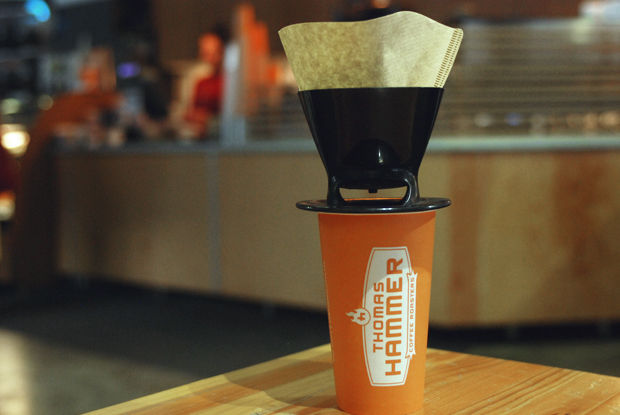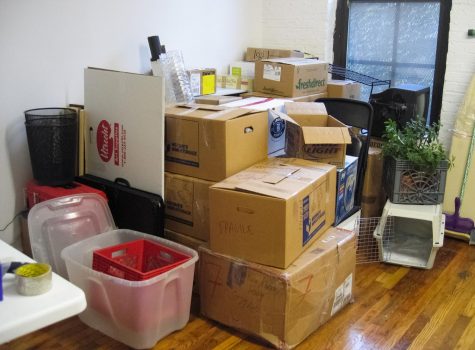Just add cream, sugar and a little science
April 3, 2015
How did the hipster burn his tongue? By drinking his AeroPress coffee before it was cool.
An AeroPress is what, you ask? In a time when single origin roast is organically farmed with respects to Jupiter’s position with our moon, coffee has become complicated for many of us. The flourishing of an Italian word as a prefix makes it sophisticated and chic. (Latte, by the way, means milk. That’s how cultured I am).
My relationship with coffee has been simple. As long as its decently strong, not burnt and if made into a steamed drink with the milk frothed properly, I’m content. At home I use a French press because I don’t need a 12-cup coffee maker with built-in timer and an auto-titrator; it’s easy to use; and doubles as a teapot if need be.
A recent discussion in my sensory evaluation class on variations of protocols in food and drink processing ended up in a discussion about brewing methods for coffee. Do the hipsters who preach their respective camps of brewing techniques really mean what they’re saying, or are we just being swindled by the shiny space-age designs and fancy names?
For the sake of science and humanity, a group of friends and I decided to do our class project on exactly that.
First, we set the stage. The good folks at Thomas Hammer let us do their experiment in their café.
Then we planned the parameters of our experiment. The design was simple; we would all taste a cup of drip coffee as our standard “reference.” Using a scale from 1 to 9, we measured attributes in terms of intensity. This included the mouth feel (body), bitterness, sweetness, acidity, length of finish (how long it lasted), and the intensity of the finish (aftertaste).
The reference gave us a frame of mind to compare the techniques, which was important experimentally because it provided context as to what it means if bitterness on one is a ‘7’ and on the other a ‘3.’ For consistency we all agreed that the attributes to the drip was a ‘5’ and our opinions would revolve around that reference.
Each treatment or brewing method was served in small espresso cups, made at its optimum ratio for water to coffee, and grind. The beans, which were Thomas Hammer’s signature blend, a medium roast, and filtered water were the only constant variable as the focus was on brewing technique.
Between the treatments the major difference was in the extraction rate at which coffee beans and water would interact. Simply put, how much coffee would be in contact with the water and also crucially the kind of pressure put onto the grounds and water.
The reference drip was what everyone expected, perfectly acceptable, but a little boring and predictable.
Two techniques of ‘pour over’ coffee were tested: Chemex and Melitta, with differences coming from the filter papers used. Thicker, the Chemex yielded in general a softer, lighter cup of coffee in terms of body, which also tempered the bitterness a smidge and enhanced the perception of sweetness (not actually sweet, remember this is all in reference to our drip) with the other attributes remaining similar.
The Melitta technique with a thinner filter paper interestingly had a longer finish with greater intensity but also a cleaner tasting cup.
The French press where steeping time (10 minutes for us) can determine dramatically how intense your coffee will be, strangely was the dullest of treatments. Part of it is due to the sediment in the cup as the filter isn’t perfect, which possibly interferes with the aromatics and acidity that brightens coffee. Oddly enough, its body wasn’t necessarily the heaviest with a score of 4.
A unanimous favorite was the AeroPress, a technique in which grounds are placed into a large-syringe like contraption, hot water poured in and steeped for less a minute before pushing under via a plunger with significant pressure forced onto the coffee.
Meant to be used with a finer grind than traditional methods but coarser than espresso, the AeroPress resulted in what could be called a light espresso. Among the other variables, it had the best body, with the most pronounced sweetness and the longest and most intense finish.
For kicks and giggles we ended with a cold brewed coffee that had been steeping for 24 hours. There’s a reason we found out that most don’t do it for more than 12 – it had the heaviest body and finish intensity that made it hard to drink – great for a wakeup call. Granted, temperature was different, but it nevertheless was an interesting insight to the differences.
So the next time you’re in a coffee shop ask for an alternative brewing method. It gives one some super hipster street-cred (you look so cool), and if anything, helps makes your daily staple a little more interesting. Just go easy on the cold brew timing.



















